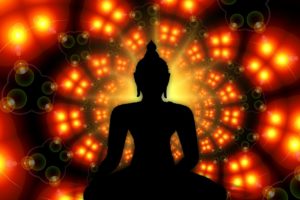When one speaks of a principle, the natural thought is of a truth that transcends given boundaries. A principle is defined as a “fundamental truth or law as the basis of reasoning or action” (Oxford English Dictionary). Principles in their true essence transcend race, class, sexual orientation, gender, religion, nationality and all other man-made confines that suggest and propagate differences. And the basic premise of yoga is exactly that; understanding and transcending differences and moving towards integration and unity.
The Meaning of word “yoga”
The word “yoga” is derived from the Sanskrit root meaning yuj “to bind, join, attach and yoke, to direct and concentrate one’s attention on, to use and apply”. It is union or communion.
When the Western world thinks of yoga, it thinks of Hatha Yoga (physical exercises and breathing exercises). But yoga is not only about the physical body. It represents the ultimate unity of body, mind, and soul. It is defined as a “practical philosophy of life by which you develop your own spiritual consciousness within and you become instrumental for the happiness and welfare of the people around you” (Swami Ranganathananda, Universal Message of the Bhagvad Gita Vol.1)
The “Bhagvad Gita” is cited as one of the most important expositions on the philosophy of yoga. The discourse was given by Krishna, the Godhead, to Arjuna, a warrior and his friend take place on a battlefield. The battlefield comes to symbolize life, while Arjuna is a man faced with a challenge as we all are at some point or another. Interestingly, the warrior who just moments before appearing on the battlefield was ready to fight, charged with anger at the injustice meted out to his brothers and himself by a tyrant cousin, becomes a muddle of emotions and despair on the battlefield. He is thrown into a depression when he sees among the opposing army, his respected teachers, the grandsire of the kingdom and other friends and family whom he cannot bring himself to fight. He lays down his arms and begins to justify to Sri Krishna his charioteer, that his love and respect for such great men disallows him taking up arms against them. His mind thus filled with fear justifies its cowardice with talks of non-violence and loyalty, all of which Sri Krishna hears and allows him to vent. When he is spent and tired, it is then that Sri Krishna sternly reminds him of his duty, the fact that it is not individuals that he fights but a principle. He has to see what the opposing force represents and put duty before kinship. His fight is a righteous one against unrighteousness. And therefore he must clear his mind and focus on his duty.
The central focus of Sri Krishna’s lecture is the call to Arjuna to steady his mind
A mind thus is thrown into emotional turmoil as Arjuna’s was, cannot think clearly. Faced with the challenge that life has brought before him, he has forgotten his training and lost concentration and balance. And it is only through yoga that he can retrieve the calmness and steadiness of mind. The first chapter is entitled “The Yoga of Arjuna’s Grief”.
 Swami Chinmayananda’s in his analysis of the Gita, explains “yoga” because it is only through the grief that one can know the difference between balance and imbalance and thus such a state for a true aspirant, encourages the movement towards one’s discovery of self and consequent unity of mind, body, and soul.
Swami Chinmayananda’s in his analysis of the Gita, explains “yoga” because it is only through the grief that one can know the difference between balance and imbalance and thus such a state for a true aspirant, encourages the movement towards one’s discovery of self and consequent unity of mind, body, and soul.
The Gita speaks of human evolution as beginning with the balancing of mind between a “sensory input and a motor output” (Universal Message of the Bhagvad Gita). Anyone who has read Stephen Covey’s 7 Habits of Highly Effective People will note the similarity in what the 7 habits strives to do-balance, equanimity. Covey’s primary point, is that reaction is a result of Stimulus and Response. But between these two there is a space. It is in that space that one has to make the decision of what the reaction will be. It is that micro space that will decide the final output and it is in that space that one needs to regulate. And it is in the regulation of activities that one moves towards a union of self.
Hinduism is concerned with the unification of self
And unification of self is about mastery of self through moderation in action, so as to be of benefit to those around. The religion also recognizes the differences between men and women and thus identifies three paths of self-realization for those of differing temperaments. Karma Yoga (Yoga of Action), Bhakti Yoga (Yoga of devotion), Jnana Yoga (Yoga of Knowledge), Raja Yoga(Yoga of Mind). Regardless of the chosen path, the central goal is establishing via daily pursuits, calmness and steadiness of mind, for Having made pain and pleasure, gain and loss, conquest and defeat the same, engage yourself in battle. So shall you incur no sin’ (Bhagvad Gita, verse 38).
Thus Vedic thought says “Yoga is not for him who gorges too much, nor for him who starves himself. It is not for him who sleeps too much, nor for him who stays awake. By moderation in eating and in resting, by regulation in working and by concordance in sleeping and waking, Yoga destroys all pain and sorrow.” (quoted in Iyengar, Light on Yoga, “Introduction”)






